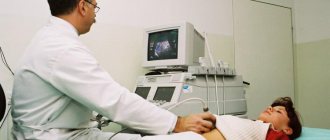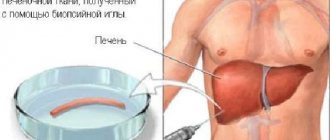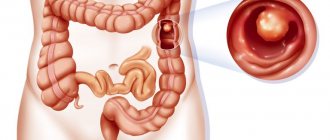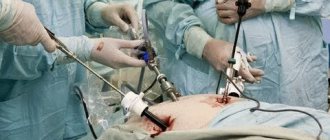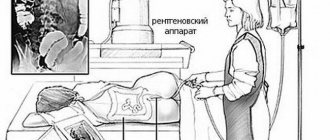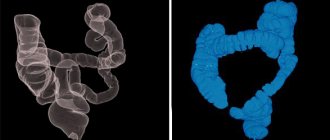Coloproctology is a complex science, and the main difficulty is timely diagnosis of diseases. It is not easy to examine the entire length of the intestine, and many diagnostic procedures cause fear in patients. In fact, patients tolerate them easily and painlessly. For example, many people don’t even know what a colonoscopy is.
Colonoscopy or FCS (fibrocolonoscopy) is an endoscopic method for examining the intestines. With its help, you can accurately visualize dangerous pathologies, as well as take tissue samples for subsequent histological analysis. In terms of accuracy and information content, colonoscopy has no equal and can be prescribed even in childhood.
Video colonoscopy without anesthesia
As a rule, the use of this endoscopic method is not accompanied by severe pain. Sometimes there is a slight tingling or distension of the intestines, which is quite tolerable.
Only a very small number of patients require anesthesia. These include the formation of an adhesive process, trauma to the mucous membrane, ulcer, neoplasm or polyp.
In such cases, patients are given local or, less commonly, general anesthesia.
Description of the procedure
The main purpose of the FCS procedure is a visual examination of the condition of the mucous membrane of the rectum and various parts of the large intestine. For this, a special device called a fibrocolonoscope is used. In addition to the possibility of visual examination of the condition of the intestine, this method allows for a biopsy of part of the intestinal stack for subsequent morphological examination and making an accurate diagnosis. It also allows you to perform a number of simple surgical operations: cauterization of a bleeding vessel, removal of a polyp, etc. In this regard, fibrocolonoscopy has found widespread use in clinical practice as a method for diagnosing pathological conditions in the intestines and a method for treating some of them.
How does fibrocolonoscopy differ from standard colonoscopy? In the latter case, a conventional rubber tube of sufficiently large diameter and low flexibility is used.
In the case of FCS, the tube is small in size and bends easily, which can significantly reduce the patient’s discomfort.
There are a number of fiberscopes that differ from each other in the length of the probe, which is necessary when examining the final sections of the intestine (shorter probe) or its initial part (longer probe). It is important to note that the procedure is not performed under anesthesia, but without the use of any local or general anesthesia. In this case, a flexible probe is inserted through the anus into the patient’s intestines and carried deeper, which makes it possible to assess the condition of all its parts.
Colonoscope
What is video colonoscopy of the intestine?
The procedure is an endoscopic examination to identify gastrointestinal diseases. To implement it, an elastic device, video equipment and equipment for pumping air are required.
The specialist examines the inner surface of the intestine on the monitor screen and makes a recording, which is saved and later used for diagnostic purposes or to monitor the treatment.
Using a colonoscope, you can also perform a tissue biopsy for histological or cytological examination to determine the nature of various neoplasms or determine the causes of the ulcerative process.
The main advantages of video colonoscopy are:
- The ability to inspect even hard-to-reach places on its internal surface.
- Creating contour detailing.
- High definition inspection.
- High information content.
- Carrying out additional endoscopic procedures.
- Harmless to the patient.
- Complete sterility of equipment.
- Special elasticity of the device for intestinal examination.
- No pain.
- Use of the most modern equipment of the latest generation.
Colonoscopy without anesthesia provides an excellent opportunity to examine the internal cavity of the intestine in all the smallest details, study its structure and image details.
This allows you to take the next steps to combat the disease as accurately as possible. Videocolonoscopy allows for early diagnosis of malignant neoplasms and the beginning of their urgent treatment.
How long can intestinal diagnostics take, according to patient reviews?
From the experience of people who have had a colonoscopy in their sleep, it turns out that they fell asleep and woke up and don’t remember anything. They don’t know how long the study lasted, but they woke up after about an hour. Many people turned to paid clinics to receive anesthesia. The procedure cost them from 9 to 12 thousand rubles, which included the study itself, anesthesia, the services of an anesthesiologist and some preliminary tests.
According to patient reviews, after colonoscopy without anesthesia, the duration of diagnosis ranged from 15 to 30 minutes. Moreover, many were surprised by the absence of unbearable sensations. It was unpleasant, that's all.
Attention! After general anesthesia, patients remained lethargic and had difficulty thinking even after 2 hours. Therefore, they advise asking someone close to you to wait for you and take you home.
When should a bowel examination be performed without anesthesia?
Anesthesia is not always used for this type of endoscopic examination. In some cases it is contraindicated.
These most often include:
- allergy to anesthesia drugs;
- suffered a heart attack or stroke;
- the entire period of gestation;
- increased convulsive readiness;
- thrombocytopenia;
- heart diseases;
- threat of embolism;
- severe mental disorders, etc.
The patient has every right to refuse the use of pain relief if he believes that it can harm his body.
Some people are afraid of possible injuries to the intestinal mucosa that will go unnoticed during video colonoscopy and therefore also refuse to use anesthesia.
If the patient wishes for the colonoscopy to take place even without the slightest pain, the procedure is carried out under local anesthesia, if the contraindications are not severe and after obtaining the person’s written informed consent.
Sometimes the doctor decides to use anesthesia if the harm from its absence is greater than from its use.
In general, answering the question about what an intestinal colonoscopy without anesthesia is and whether it hurts during its procedure, experts note that the best results are shown by a diagnostic procedure that takes place without anesthesia when the patient is fully prepared and able to completely relax the muscles. Minor discomfort is tolerable and is only temporary.
Drug Fortrans
This method is modern and safe, but requires more time. However, it allows you to obtain more informative data when performing a colonoscopy.
The active ingredient of Fortrans is Macrogol 4000. Each package contains four sachets of the drug, which is equal to the required dose for one cleansing procedure. Compared to a cleansing enema, this method is more expensive - the cost of the drug is approximately 500 rubles.
Endoscopic picture for various pathologies
Important! Despite the fact that manufacturers recommend using four sachets of medication for each cleansing procedure, the doctor may recommend a different amount of the drug depending on the individual characteristics of the patient. Therefore, it is not recommended to start using Fortrans on your own.
Depending on what time the procedure is scheduled, preparation for it may vary. Let's consider the features of using Fortrans in cases where FCS is scheduled for the first and second half of the day.
Procedure in the first half of the day
If fibrocolonoscopy is prescribed to a patient for up to 14 hours, it is recommended to use Fortrans to cleanse the intestines. This laxative allows you to cleanse the intestines quite effectively; you do not need to adhere to a slag-free diet or perform a cleansing enema in advance.
Preparation for fibrocolonoscopy
To prepare, you need to purchase four packages of the drug. This amount of the product will be sufficient for patients with increased body weight, adhesive intestinal disease, constipation and other conditions in which the activity of the muscle wall of the large and small intestine is reduced.
You should not eat 12 hours before the procedure. Each package of Fortrans should be dissolved in a liter of warm boiled water. For such a volume of liquid, it is better to take a 1.5 liter plastic bottle.
Within four hours, starting at 15:00, you need to drink 3-4 liters of the dissolved product. On average, it is recommended to drink one liter of solution per hour. Patients with gastrointestinal diseases may find it difficult to drink this amount of fluid in a short period of time. In this case, belching, nausea and other symptoms may appear. To avoid this, it is recommended to take one Motilium tablet an hour before the procedure. This is a prokinetic agent - a remedy that improves intestinal motility and accelerates the movement of contents.
Drug Fortrans
After one to two hours after the start of preparation, loose stools should appear. The urge to defecate should occur several more times before 10-11 pm. In some cases, loose stools may occur later. Preparation can be considered complete when the urge stops completely.
A small breakfast is allowed the next morning. Food should have a minimum amount of fiber. If you plan to use anesthesia during the procedure, then eating in the first half of the day is contraindicated.
Procedure in the afternoon
Colonoscopy is not often performed at 2 pm or later. However, if the procedure is scheduled for this time, it is necessary to use Fortrans according to a different scheme.
How to use Fortrans
The basic principles of intestinal cleansing in this case do not differ from the previous one. It is also recommended to follow a slag-free diet, and the amount of the drug is four sachets. However, they start taking the drug from 20:00.
The day before the colonoscopy, breakfast, lunch and a small dinner are allowed. The last meal is allowed no later than 18:00. You should avoid carbonated drinks and other foods that can cause flatulence.
During the time interval from 20:00 to 22:00 you need to drink two liters of the product diluted in warm water. The urge to defecate should appear within 1-2 hours, and stool may appear until about midnight. After their cessation, the first stage of intestinal cleansing is considered complete.
A colonoscope allows you to evaluate the condition of the entire colon
The second stage also includes two doses of medication on the day of the procedure. You need to drink two liters of solution between 8:00 and 10:00. Eating food at this time is prohibited; you are allowed to drink small quantities only of weak tea or water.
Important! If the patient has poor tolerance to Fortrans, you can replace its intake on the day of the examination with two cleansing enemas with a break of 1-2 hours.
If all recommendations are followed, the urge to defecate should stop by approximately 13:00. After this, you can drink a glass of plain water or tea. When it is planned to use anesthesia during the procedure, you can drink liquids no later than two hours before the FCS.
Preparation of Fortrans solution
Restrictions on bowel examination without anesthesia
In some cases, the use of anesthesia becomes necessary.
These include:
- Crohn's disease;
- ulcerative colitis;
- hemorrhage into the intestinal cavity;
- polyposis;
- spastic constipation;
- flatulence;
- cachexia;
- hereditary predisposition to malignant neoplasms;
- undergone surgery to remove a tumor;
- suspected cancer;
- feeling of constant distension in the intestines;
- frequent diarrhea;
- Iron-deficiency anemia;
- decreased hemoglobin levels, etc.
Therefore, patients who are interested in how to undergo a colonoscopy without anesthesia should first contact their healthcare provider for a complete examination and advice regarding its use.
Main indications for the procedure
Routine fibrocolonoscopy is recommended to be performed at least once every five years. The World Health Organization recommends it for all people over 40 years of age. This preventive measure will allow for the timely detection of a number of dangerous diseases that have minimal clinical symptoms in the initial stages. Urgent indications for this study include:
- severe pain in the large intestine;
- mucous or purulent discharge from the rectum;
- persistent stool disorders of unknown etiology;
- long-term anemia;
- sudden weight loss of the patient;
- suspicion of the development of colon tumors.
Preparing for intestinal colonoscopy
In order for the procedure to bring maximum effect, certain rules must be followed.
You need to stick to a diet. Within three days you should exclude from your diet porridge, canned food, pickles, liver, fatty meats, fish, vegetables, spices, fruits, and bread. It is not allowed to drink milk, sparkling mineral water, lemonade, nectars from concentrates, or alcoholic drinks.
It is worth giving preference to mashed potatoes, pasta, rice, hard-boiled eggs, lean meat broth, cow butter, and bread. It is advisable to wash down food with jelly or natural juices.
On the eve of the study, it is necessary to completely empty the intestines using a cleansing enema. In addition, it is necessary to take laxatives, as well as substances that prevent excess gas formation.
Before performing a video colonoscopy, you need to take at least two liters of clean drinking water without gas. The next day you should drink the same amount of liquid. If the procedure is carried out early in the morning, then you need to drink four liters in the evening.
When anesthesia is planned, preparations are made for it immediately before the examination.
The patient must come to the appointment strictly on an empty stomach. It is better to remove contact lenses and dentures in advance.
Cleansing enema
This is the simplest method of cleansing the intestines on the eve of the diagnostic procedure. However, it has a number of disadvantages. For example, the use of a cleansing enema leads to unpleasant sensations, discomfort, and also negatively affects the state of the intestinal microflora. If performed incorrectly, this method may not be effective enough.
Despite all the disadvantages, many patients scheduled for colonoscopy prefer this method of bowel cleansing.
Indications and contraindications for performing a cleansing enema
This is due to the following features:
- low cost;
- ease of use;
- quick result - compared to other methods of cleansing the intestines, this method is the fastest;
- does not cause side effects like some laxatives.
Important! This procedure is contraindicated for patients with inflammatory diseases and intestinal tumors, as it can lead to the development of complications. The same applies to people with hemorrhoids and anal fissures.
Execution technique
To cleanse the intestines, at least three procedures are required. The first two with a break of 1-2 hours are performed in the evening, and the rest in the morning. Each infusion should have a volume of at least one and a half liters. It is advisable that the water be boiled; bottled water can also be used.
Technique for performing a cleansing enema
Important! The temperature of the liquid should be between 20-36 degrees. Colder water should be given to patients with hypotonic constipation, and warm water should be given to people with intestinal spasms.
Before starting the procedure, you must lie on your left side or get on all fours. The tip is lubricated and inserted into the anus about 10 cm. After this, a slow infusion of water begins. After there is no content left in Esmarch's mug, you need to remove the tip and keep the water in the intestines for 10-15 minutes. If the urge to defecate becomes unbearable, you can empty the colon earlier than this.
The structure of Esmarch's mug
Why is bowel cancer at risk for meat eaters?
And now a little about what is known today about the prevention of colorectal cancer. Of course, a predisposition to cancer is always a genetic defect. And the exact causes of colorectal cancer, as well as any other malignant neoplasm, are not completely clear to medical science. But proctologists are inclined to believe that intestinal cancer has begun to declare itself more often as a disease of civilization.
This fact confirms this. In countries where the basis of the diet is fast food with a large amount of animal fats, refined foods and preservatives that slow down peristalsis, colon and rectal cancer is more often diagnosed than in countries where, due to national traditions, food with a large amount of fish, vegetables and cereals is accepted. Leading this sad list are traditional meat-eaters - countries where they love steaks, barbecues, and smoked sausages. These are the USA, Canada, Israel, Australia, Germany. While in peoples where a vegetarian diet and seafood are honored, colorectal cancer is very rare.
Doctors deduce a pattern: meat and animal fats accelerate the growth of intestinal bacteria, which produce carcinogens. Fried or smoked foods are even more harmful to humans. As opposed to meat products, plant foods are rich in fiber, which improves intestinal motility. There are also a lot of antioxidant vitamins A, C and E in grains, vegetables, fruits, and greens, which have anti-cancer properties.
Benefits of Colonoscopy
Approximately 25% of all cases of polyps detected in the large intestine occur in patients over 45 years of age, so men and women who have reached this age are recommended to have a colonoscopy once a year. Those who have close relatives with intestinal polyposis should especially pay attention to their health.
The benefits of the survey include the following:
Colonoscopy is a highly effective and most common method for diagnosing various diseases of the digestive tube. This examination is the most accurate and informative among other alternative diagnostic methods. The use of the most modern endoscopes with digital images, which, when magnified, display a picture in the highest quality on the screen. This opportunity allows you to examine more carefully even the most inaccessible areas of the intestine, which is very important for the diagnosis and prevention of dangerous diseases. When using some devices, a doctor is able to detect malignant tumors at a very early stage (using dyes, optical fiber chromoscopy, 100-150 times magnification). This gives patients the opportunity to treat the disease without surgery. During a colonoscopy, it is possible to obtain a biopsy of intestinal tissue if necessary. During a colonoscopy, the doctor can stop bleeding, remove polyps, strictures in the intestine, and patients will not require additional surgery.
Need for pain relief
Many patients wonder whether colonoscopy of the intestine is painful? Indeed, colonoscopy is painful to one degree or another. And doctors prefer to do colonoscopy of the intestines using anesthesia or painkillers. Pain, discomfort and a feeling of heaviness can occur as a result of intestinal distension with air, especially if the mucous membrane is excessively smoothed. The diameter and flexibility of the colonoscope also matter. In addition, against a background of fear, spasms of the muscular lining of the organ may occur. This also leads to pain.
Painkillers and narcotics are used:
- To prevent the patient from experiencing pain when inserting a colonoscope.
- If a person has concomitant diseases or there is an adhesive process in the abdominal cavity. In childhood, colonoscopy is performed only under anesthesia, since the child, in most cases, does not realize the need for the procedure and may interfere with its implementation.

